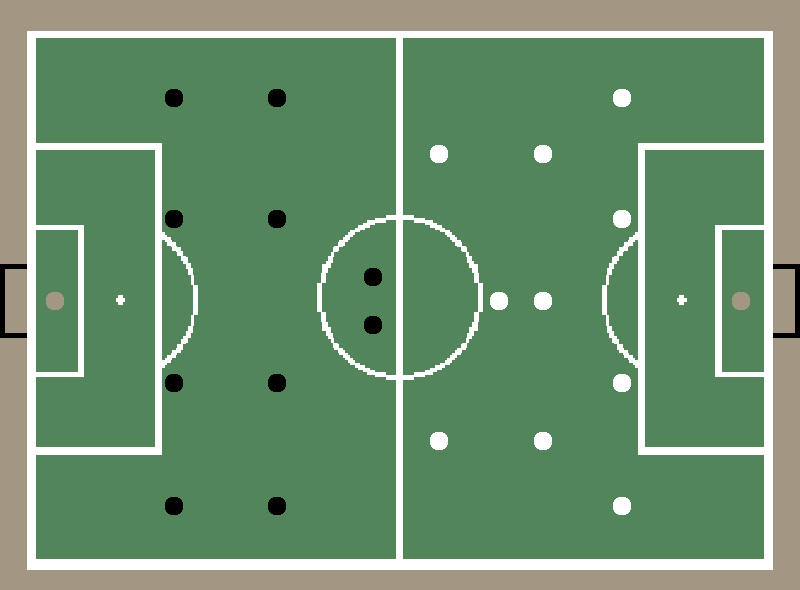Photo by Wikimedia Commons CC BY-SA 1.0
When it comes to tactics, strategies and philosophies, football has never been static or one-dimensional. Often described as “cyclical”, the game has seen tactical trends come and go, while new ideals have continually emerged to “break” older methodologies.
As we move forward, managers, analysts, bettors and supporters alike all try to define what comes next. So, what are the future football tactics trends? Where will the cycle of tactical evolution take us next?
From possession to transition: the pendulum swings back and forth
For the best part of a decade, possession-based football was in vogue with the Spanish and Barcelona teams of the Del Bosque and Guardiola eras inspiring copycat versions all over the globe.
Short passing patterns, precise pressing structures and midfield overloads were the order of the day, however, as always, what seemed like an unbeatable approach was eventually combatted by alternative blueprints.
Today, teams have rediscovered the power of transition, with fast breaks, vertical football and speed on the flanks among the attributes wielded by the best teams.
French giants, PSG, who won the Champions League last season, have a style that marries the best of possession-based football with the explosive power of rapid breaks and ball-carrying finesse under Luis Enrique.
Indeed, even the Tiki-Taka professor himself, Pep Guardiola, has his current Man City team playing in a more direct style in a bid to match the physicality and running power of his club’s opponents in the Premier League.
Now, teams that excel on transition tend to dominate online football betting markets in both week-to-week fixtures and in the outright stakes. But what comes next? If the cycles continue, what will eventually be the antithesis of counter-attacking, transitional football?
Set-pieces are dominating the current tactical ecosystem
As we enter the next phase of tactical evolution, the application of algorithms and analytics are having a bigger say and a greater influence in how managers are compiling their pre-game strategies.
Clubs are now relying on predictive models and deep data-led insights to find new angles of approach. Every movement on the pitch is now calculated and planned to the nth degree, and as a result, set pieces like corner kicks and deliveries into the box from free kicks are providing more match-changing moments than ever.
With teams finding it more and more arduous to manufacture goal-scoring chances from open play, set pieces have become the favoured route to goals.
In the Premier League early exchanges this season, 15 of the 20 competing teams have already scored at least one goal from set pieces, highlighting just how much emphasis is being placed on how teams operate during dead-ball sequences.
Arsenal are a prime example of how set pieces have become a prominent weapon. Despite wielding a squad packed with star quality, Gunners’ boss Mikel Arteta has built much of his gameplan around maximising returns from set pieces. It’s not always pretty, but it has been effective.
However, with open-play rigidity common and an over-reliance on set pieces developing, the antidote to modern mechanical football might be an old tactical approach reimagined.
54'—Arsenal corner kick ➡️ goal
— B/R Football (@brfootball) December 4, 2024
73'—Arsenal corner kick ➡️ goal
The Gunners have scored 22 goals from corners since the start of last season 😤 pic.twitter.com/fnkM2hyNjO
Dribbling, spontaneity and individual brilliance to return?
One of the more exciting emerging patterns is a rekindled value for spontaneity and creativity on the ball. With systems and positional play so expertly drilled, the return of the free-thinking maverick feels overdue.
Expert dribblers and players who can pass the ball with imagination are likely to be the key to breaking lines and unlocking defences, and the term “individual brilliance”, which had attracted negative connotations, could start to claw back its original meaning.
In recent years, risk aversion has been paramount, however, with instructions to limit mistakes prioritised above all else, much of football’s spark has been extinguished as has players’ ability to be more expressive in possession.
A return to a version of the sport where the mavericks and enigmatic free spirits take centre stage again would be a welcome one, with supporters often lamenting the lack of entertainers in the modern era.
Hybrid roles & positional fluidity
Alongside individual brilliance and the emergence of free-spirited performers, the future of football tactics could feature more fluid formations, with hybrid roles and greater positional fluidity.
Classic positions, like holding midfielder, winger and striker aren’t exactly disappearing, but they are definitely changing.
Strict 4-3-3, 3-5-2 or 4-2-3-1 formations have now become interchangeable, with teams altering their shapes based on the position of the ball, their opponents and the overall game state.
Indeed, talk to any coach today and they will tell you that starting formations are largely irrelevant and that teams often switch things up tactically a number of different times in one sitting.
While formations look static on paper or in pre-match graphics, in reality, they are fluid and malleable and as tactics continue to change, positional fluidity is likely to increase even further.




